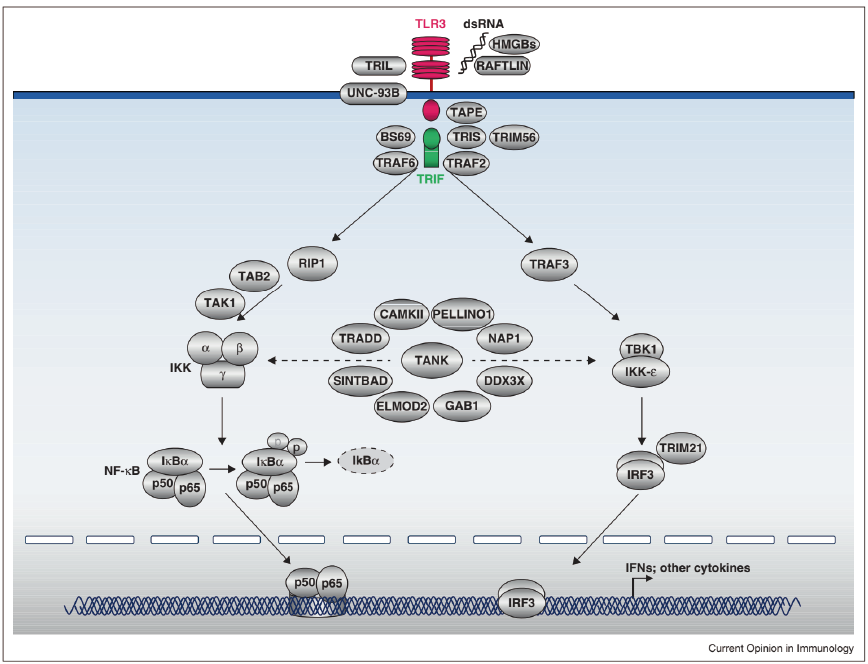
Our promise to you:
Guaranteed product quality, expert customer support.
 24x7 CUSTOMER SERVICE
24x7 CUSTOMER SERVICE
 CONTACT US TO ORDER
CONTACT US TO ORDER
TLR3 Gene Editing 
Toll-like receptors (TLRs) are a family of pattern recognition receptors that promote efficient innate immune response via recognizing the conserved pathogen-associated molecular patterns (PAMPs) or endogenous danger associated signals (DAMPs). Recognition of those signals and subsequent activation of signaling pathways result in cytokine and chemokine production and maturation of adaptive immune response. TLR3 belongs to the Toll-like receptors family. It is a highly glycosylated type I membrane receptor involved in viral double-strand RNA recognition and initiation of the immune response. Besides, TLR3 can regulate the functions of immune cells, pancreatic β-cell, adipocytes and glucose homeostasis. TLR3 is also a death factor that can trigger the release of apoptotic bodies inducing cancer cell apoptosis.
It has been shown that intracellular signaling of TLR3, in contrast with other TLRs, is only in TRIF dependent manner. Following TLR3/ligand interaction, TIR domain of TLR3 and TRIF interact with each other and lead to TRAF6, RIP-1 and TBK1 activation. This event activates several inflammatory transcription factors including AP-1, IRF3 and NF-κB. AP-1, IRF3and NF-κB are responsible factors that transcript from several genes including chemokines, inflammatory cytokines, co-stimulatory molecules and addressing as well as homing molecules.
 Figure 1. TLR3 signaling pathways leading to the activation of NF-kB and IRF3.
Figure 1. TLR3 signaling pathways leading to the activation of NF-kB and IRF3.
TLR3 and Type 2 Diabetes
It has been documented that TLR3 acts directly on the function and replication of pancreatic β-cells. For example, Wang and colleagues revealed that TLR3 and its related signaling molecules like TRIF and p38 play a negative role in the proliferation of pancreatic β-cell lines. Besides, another study showed that dsRNA induces apoptosis in pancreatic β-cells by activation of TLR3. Several molecules that participate in the pathogenesis of type 2 diabetes (T2D), such as apo-proteins, have interactions with TLRs. The data demonstrate that TLR3 plays a key role in metabolic homeostasis focusing on the pancreatic β-cells as one of the cellular targets for this regulation. But these are not the only cells in which insulin pathways are regulated, because defects in TLR3 expression leads to diminishing insulin resistance in muscle cells of obese patients. Moreover, it has been found that increased expression of TLRs and their related signaling molecules resulted in mild inflammation, insulin resistance and exacerbate islet dysfunction. Thus, research into future lead therapies may explore the use of TLR3 agonists/antagonists as a beneficial therapeutic approach for the treatment of T2D.
TLR3 and Malignant Pleural Mesothelioma
TLR3, initially described as a pro-apoptotic and death factor, is also involved in tumor immunity. Recently, it has been shown that TLR3 triggering induces strong upregulation of both MHC class I and PD-L1 on neuroblastoma cells, by affecting the cytokine profile. Moreover, the agonists of TLR3 are currently tested alone or in combination with tumor antigens and have shown success in enhancing immune responses and generating an antitumor activity. Studies found that TLR3 was almost always expressed with high intensity by TCs in MPM, particularly in epithelioid and biphasic subtypes, but it tended to be lost in the sarcomatoid subtype. Therefore, whereas TLR3 is expressed by the vast majority of MPM, PD-L1 is expressed in less than 20% of MPM, and its expression in TCs is a poor prognostic factor. TLR3 agonists could be tested in most MPM of epithelioid and biphasic subtypes, with the exception of sarcomatoid subtypes. Depending on their PD-L1 status, combination with anti–PD-L1 or anti–PD-1 therapies could be proposed to potentiate anti-tumor immune effects.
TLR3 Gene Editing Service
CRISPR/Cas9 PlatformCB at Creative Biogene is dedicated to offering comprehensive CRISPR/Cas9 gene editing services and products for academic research, biotech research and pharmaceutical drug discovery. With deep gene editing knowledge and extensive experience in experimental operation and data processing, we help you effectively control TLR3 genes knockout/knockin/point mutation in cells or animals via CRISPR/Cas9 technology.
| Service | Details | Alternative cell lines or animal species |
|---|---|---|
| TLR3 Gene Editing Cell Line Generation | gRNA design and synthesis Transfect the cell lines you're interested Select the high expression cells and sort monoclonal cell Validate the knockout/knockin/point mutation of TLR3 by PCR and sequencing Provide cryogenic preserved vials of stable cells and final reports | HEK239T, Hela, HepG2, U87, Ba/F3, CHO, MDA-MB-453, MDA-MB-231NIH3T3, T47D, Neuro2a, MCF7, RKO, K562, RAW264.7, etc. |
| TLR3 Gene Editing Animal Model Generation | TLR3 gene conventional knockout animals TLR3 gene conditional knockout animals TLR3 point mutation animals TLR3 knockin animals | Mouse, rat, rabbit, zebrafish, C. elegans, etc. |
| CATALOG NO. | PRODUCT NAME | PRODUCT TYPE | INQUIRY |
|---|---|---|---|
| CCKM0879 | B6J-Tlr3em1Cd | Knockout Mouse | Inquiry |
| CDKM-0663 | B6J-Tlr3em1Cflox | Knockout Mouse | Inquiry |
| CSC-RT2115 | Human TLR3 Knockout Cell Line-A549 | Pre-Made Knockout Cell Line | Inquiry |
References:
- Karimi-Googheri M, Arababadi M K. TLR3 plays significant roles against hepatitis B virus. Molecular biology reports, 2014, 41(5): 3279-3286.
- Sepehri Z, et al. TLR3 and its roles in the pathogenesis of type 2 diabetes. Cellular and Molecular Biology, 2015, 61(3): 46-50.
- Combaz-Lair C, Galateau-Sallé F, McLeer-Florin A, et al. Immune biomarkers PD-1/PD-L1 and TLR3 in malignant pleural mesotheliomas. Human pathology, 2016, 52: 9-18.
- Zhang S Y, et al. TLR3 immunity to infection in mice and humans. Current opinion in immunology, 2013, 25(1): 19-33.